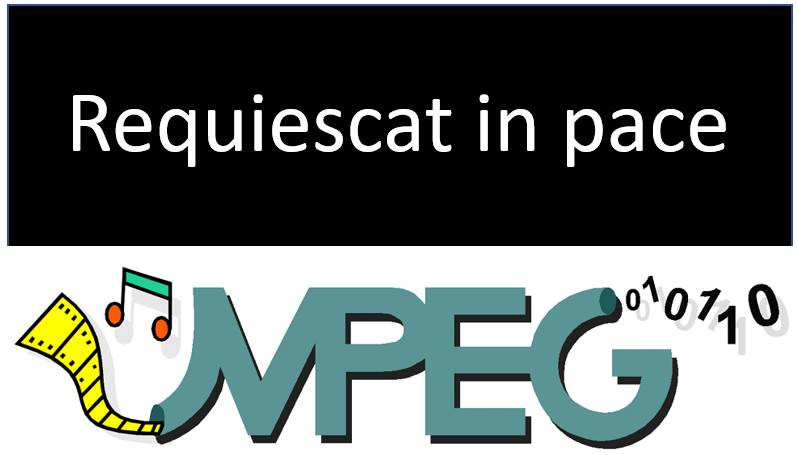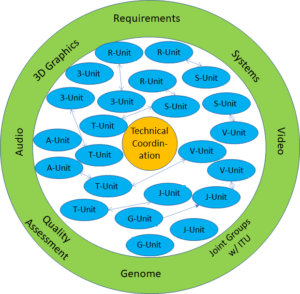1 Introduction
For 32 years, MPEG was a unique player in the standardisation space. Contrary to what had been the rule in previous decades, instead of being variously subdivided and controlled by governments, countries, industries and companies, media standards were autonomously developed with high quality and in a timely fashion by a group – MPEG – that was impervious to external influences and did not practically report to anybody.
That was true for, say, the first quarter of century of MPEG life. In the last few years of MPEG life, however, some tectonic changes had seriously hampered MPEG’s ability to serve the industry with the same level of efficacy as in years before.
The disbandment of MPEG following the successful attack by obscure forces decided in June 2020 has put the final seal on a unique adventure.
2 Why there was MPEG
I always considered a slap in the face of billions of people the fact that television had been designed to be non-interoperable across most countries. I thought that if the variety of lower-level technologies had been used to create walled gardens, digital technologies could be used to define formats that were abstracted from these lower-level technologies. If those formats – compressed because of the limited bitrate offered by physical media practically available at that time – could become accepted standard, universal communication would become possible. Those formats would be welcomed by consumers, but probably even more by manufacturers, and content and service providers who could flood a global market with their products, content and services.
MPEG was established in January 1988 by the entente of two people: myself who had the vision and Hiroshi Yasuda who had the standard committee I needed – JPEG.
3 The MPEG business model
Over the years MPEG has developed and rationalised what can be called the “MPEG business model”, whose main elements are:
- Media technologies are used by different industries and they are essentially the same. However, each industry has its own requirements.
- Media standards should not be industry-specific but a single standard should serve them all.
- Understanding the requirements of the various industries is essential, so as not to design a standard that manifestly neglects the needs of some industries.
- A given media type should have a single compressed format with the highest performance made possible by the technology available at the time.
- MPEG should be made aware of the different available technologies through Calls for Proposals made public so that any technology holder could propose them.
- Media types are not independent: video, audio and other data should be handled in a unitary fashion, taking into acccount the specificities of each data type.
- The way compressed data are transported should be handled jointly with how media are compressed.
- The development of standards involving disparate technologies and their integration should be overseen by a management-level integration effort.
- Digital does not kill politics, but the unitary approach facilitates the reduction of political issues to mere technology issues.
- Provide a fast track to facilitate injection of innovation into the standards process.
- The opportunities offered by the burgeoning field of digital media technologies and services are infinite. However, opportunities don’t come, they have to be found.
- Liaison with other standards bodies are important because they can become customers or even partners in a common development.
- Don’t operate in the shadow, make things public to the extent possible. The publicity given to ad hoc groups, press releases, working drafts etc. made industry familiar with things to come.
4 The success of the MPEG business model
The intentions of the MPEG business model have been well accepted by industry, but also by consumers for which MPEG is a brand name.
Here is a summary analysis of how the MPEG business model was a success:
- In the early MPEG days, making an MPEG video or an MP3 codec was quite an effort. The fact that there was a single standard allowed industry not to disperse their efforts in multiple streams.
- The MPEG standards were integrated (audio-video-system) but their components could be used independently, as done by ATSC who adopted the MPEG-2 Video and System standards but used a proprietary solution as audio standard.
- The single standard was not a monolith, but structured in profiles and levels. This gave MPEG standard the “one size fits all” attribute, otherwise an oxymoron.
- The MPEG modus operandi attracted many researchers because MPEG acted as channel between industrial research and academia to standardisation.
- Attention to liaison with other standards bodies and industry fora for the support of industry-specific features. With this policy MPEG has developed an vast portfolio of customers.
- MPEG triggered the revival of patent pools, devised to facilitate remuneration of intellectual property and to accelerate deployment of MPEG products.
- The MPEG success in the market place allowed MPEG to defend its autonomy in regard to external “interferences”.
- Standards have been developed in response to documented and defended needs, rejecting the typical policy of developing standards only if blessed by big players.
- The MPEG operation and results lead everybody to acknowledge that there was no “grand old man” pulling the strings, but only the desire to serve the industry.
- Large participation of industrial research and academia because MPEG was the natural “next step” in many research projects.
5 The clay feet of the MPEG giant
One should never think that human endeavours will stay unchallenged, especially when we deal with long period of time and when the time is today when things happen faster and faster.
In the last decade, the environment in which MPEG operated underwent tectonic changes.
Tectonic change #1. The environment gradually transitioned from an extremely varied ecosystem of MPEG customers, to one where the number of customers was reduced because of the inability of many players to stand competition from successful players.
Tectonic change #2. Many of the companies who stopped using MPEG standards for their business, opted to keep their valuable human resources to develop technologies. In other words, they became Non-Practicing Entities (NPE). Their attitude changed from joining MPEG because they needed standards, to joining MPEG just to inject their IP into the standards.
Tectonic change #3. Because they were non-practicing, NPEs were not interested in patent pools delivering good licences in a timely manner. Their only interest was maximising the profit they could make from their patented technologies. Patent pools could even become an obstacle to their plans.
Tectonic change #4. The metamorphosis of one time high-flying companies to NPEs accelerated a process that was already in place: the birth of companies entirely dedicated to producing IP with little or no interest in using their IP to do business that was not monetising their IP. Tectonic changes #3 and #4 explain why HEVC has 3 patent pools, whose members sometimes belong to more than one patent pool, with different non-converging licences and some 10 companies who are assumed to be patent owners but do not belong to any patent pool and do not make their licences known.
Another reasons that can be added to explain MPEG’s clay feet is competition from other standards. Far from being a negative point, competition is an advantage for those who compete (not necessarily for industry and consumers), but only if competition happens on a level play field. This was not the case for MPEG who was subjected to ISO rules that were not updated probably because keeping outdated rules was convenient to some of the players who occupied vital nerve centres of ISO.
6 The digital media Fort Alamo
Since the beginning, my role in MPEG has always been to produce neutral standards upholding the values of MPEG. From the above, however, it is clear that the MPEG values were no longer convenient to too many players. I do not know if there was a General Antonio López de Santa Anna in command of the army besieging MPEG. For sure the prospects of the bounty kept together an army with disparate goals:
- Media standards are just too important to be left to a body that did not actually report to anybody. They could not care less that the body had created and served an industry with its standards.
- ISO National Bodies collect stickers, not in the form of soccer player stickers, but Secretariats. Japan held the Secretariat of a virtual committee called SC 29 MPEG was a part of and wanted to take back the authority that they had never exercised.
- The largest digital media market could not afford to be just one participant in MPEG, they wanted a position befitting their industrial role.
- Combined interest of some academics (I get funds because I work for MPEG) and NPEs (the MPEG business model is antithetic to me).
- Some Lilliputians wanted to get the position that their thought should be theirs.
- The ISO Central Secretariat bureaucracy was keen to get rid of the MPEG exception. I believe there were other darker reasons I should talk about one day.
- Envy from other less successful ISO committees. My preferred example is SC 24 Computer graphics, image processing and environmental data representation (a mouthful). I would have a hard time to mention a standard produced by SC 24 in its 34 years of existence.
7 MPEG is dead
MPEG, as an organisation, is dead, but the MPEG name, which resides on the mouths of billions of people, survives. Because the MPEG name is universal, some people think that they can use it.



